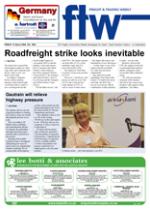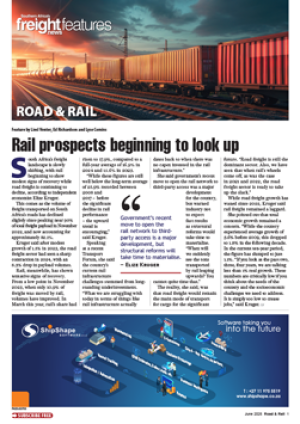Against the background of
the global recession, now
more than ever South African
shippers cannot afford the
cost burden of an inefficient
supply chain.
It’s a fact of which
Transnet Port Terminals CEO
Tau Morwe is patently aware
as the transport utility counts
the costs of the crisis in
dwindling import and export
volumes.
Morwe has made it clear
that stakeholder engagement
will be critical if it is to
weather the stormy seas of the
recessive climate ahead.
“We recently met with
the leadership of Anglo
American and have been
doing the same with other
relevant stakeholders like
the shipping lines, Toyota,
Daimler Chrysler and the
like,” Morwe told FTW.
The organisation has
recently completed its
turnaround strategy. “The
next five years will be
characterised by a programme
of growth – and that will be
underpinned by improved
efficiencies through
integration between port
and rail, optimisation of our
capital expenditure plan and
the deployment of skilled
staff who operate in a safe
environment,” said Morwe.
“We have for some time
lagged behind in terms of
adequate infrastructure.
“Five to six years ago
we had a $100 congestion
surcharge on containers
moving through Durban,
which was a huge a burden on
the economy.
“Through the corridor
strategy we have improved
our product both in terms
of the port and rail systems
to ensure that we offer a
competitive service.”
Key to this is the hub and
spokes concept. “World Bank
studies demonstrate the costefficiencies
of hubbing.
“If you look at the rest of
the world, there are currently
25 hub ports around the
world, mainly in South East
Asia. Africa is the only region
that doesn’t have a hub port.”
Its introduction in South
Africa would give cargo
carriers some competitive
capability in terms of
reducing costs – but it would
also boost the country’s
seafaring status.
“With the introduction of
a hub we would also need
connectivity.
“For international players it
would mean they would have
access to world class terminal
services and a reduced stay in
the port which translates into
greater efficiencies. In terms
of the supply chain it would
reduce costs,” he said.
The key challenge now
revolves around people, in
Morwe’s view. “We have
invested in infrastructure and
equipment. We now have to
ensure that people are up to
date in terms of improving
skills.
“We must focus on
planning in the ports and the
key challenge is to ensure that
government and ourselves are
on the same page.”
TPT engages with stakeholders in drive for efficiency
13 Mar 2009 - by Joy Orlek
0 Comments
FTW - 13 Mar 09

13 Mar 2009
13 Mar 2009
13 Mar 2009
13 Mar 2009
13 Mar 2009
13 Mar 2009
13 Mar 2009
13 Mar 2009
13 Mar 2009
13 Mar 2009
Border Beat
Poll
Featured Jobs
New
New
